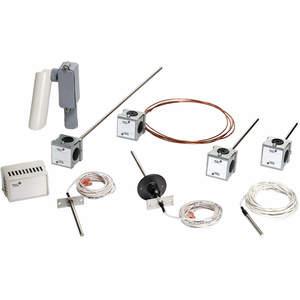Johnson Controlstemperature sensors of TE-6300 line are ideal for diverse temperature sensing needs in building automation systems and direct digital control systems. Johnson Controls TE-635AM-2 temperature sensor is used in wall mount, well insertion, strap mount, duct probe & averaging and outdoor air applications. Johnson Controls TE-635AM-2 is available in a package with the required mounting accessories for ease of installation and reduced commissioning time & cost. Users can check out Johnson Controls temperature sensorspage on or website for more variants of this sensor.
Features:
- Johnson Controls TE-635AM-2 thin-film platinum type, temperature sensor has 1k ohms sensor reference resistance at 32 degrees F (0 degrees C).
- It can be operated at temperatures ranging from -50 to 220 degrees F.
- This TE-635AM-2 sensor has a 6 inch (152 mm) long probe that can be directly mounted on a thermowell for quick installation.
- It comes with a corrosion-protected steel enclosure for covering the connections and preventing accidental disconnection or error.
- This sensor has an accuracy of +/-0.35 degrees F at 70 degrees F.
- It connects to 14 to 22 AWG connections using wire clamps.
Compatible Accessories:
- TE-6300W-101 & TE-6300W-102 Thermowells: They come with thermal grease for direct mounting of the 6 inch probe of TE-635AM-2 temperature sensor without using an external adaptor. These thermowells have stainless steel or brass with copper bulb construction for corrosion resistance.
Standards and Approvals:
- Meets UL 1995 plenum use requirements
Frequently Asked Questions:
Q. What are the uses of thermal compounds in thermowells?
A. Thermal compounds like thermal grease or paste are used to fill the air gap between a temperature sensor & thermowell walls. These compounds improve stability and provide accurate temperature readings.
Q. How does a temperature sensor work?
A. The temperature sensors work on the principle that the temperature change cause change in the electrical resistance of a material. Temperature sensors are made of a wide variety of materials for varying accuracy & application requirements. The change in electrical resistance results in voltage change that can be measured by a controller for indicating temperature readings.




